Understanding the Modern Bio-Filter
by Web Wheeler 
Originally published in "Our Discus", Vol 4, Issue 1 (1990), North American Discus Society (N.A.D.S.) - Updated April 2010

Discus Aquarium
Courtesy of George Devires
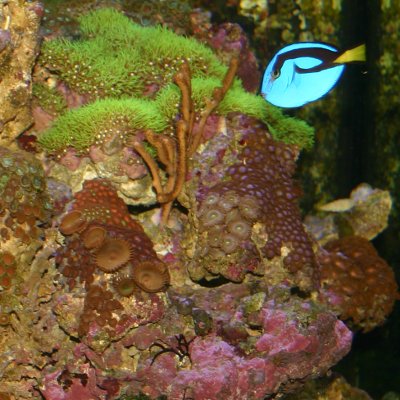
Saltwater "Reef" Aquarium
Courtesy of Big Al's Aquarium Services
I have been an aquarium hobbyist for over forty years. I also owned an aquarium supply business which manufactured high quality filtration, lighting, and water chemistry products. I have made it my business to learn as much as I can about aquarium filtration methods and products that are currently available.
Importance of Good Water Filtration
I am going to assume the importance of ridding the aquarium of toxic waste products as quickly as possible is well understood by everyone, and that a long discussion about the importance of good aquarium water filtration is unnecessary. I would, however, like to emphasize the results of poor quality filtration. First, a high level of ammonia in the aquarium can kill fish outright. This is especially noticeable with baby fish, which will quickly die if left in foul water, or with larger fish being shipped in small bags over a long period of time. Secondly, even a low level of ammonia in aquarium water can cause environmental stress which will reduce your fishes resistance to disease and parasites. Please refer to the book "Diseases of Fishes", book 5: Environmental Stress and Fish Diseases, TFH Publications, for more on this subject. I would also like to mention the many testimonials which can be found throughout aquarium literature citing good water filtration as the secret to a successful aquarium.
Conventional Filtration Limitations
Before beginning a discussion of the applications of filtration techniques to the aquarium, I would like to present two limitations of conventional filtration that often limit the intended results of improved water quality. The first limitation is simplistic but worth noting since it occurs fairly often; mechanical filters which are left uncleaned do nothing more than move debris from one place to another. Many aquarium hobbyists would do well to keep this in mind when they remark on their filter's performance, "That filter really works... look at how dirty it is!" Please do not make the assumption that I do not believe in mechanical filtration - my feelings are quite the contrary, but that in order for a mechanical filter to work, it must be cleaned regularly.
The second limitation is more complicated, but you don't have to be a rocket scientist to appreciate it. For many years biological filtration has been carried out in the aquarium with the use of sponge and under-gravel filters, which work quite well except when they are really required to work! Let me illustrate this point with the following example: suppose one of your aquariums springs a leak and you are forced to remove the existing fish and combine them with fish in another aquarium. As you would expect, with more fish in your remaining aquarium, there is an increase in ammonia being produced. You also expect the bacteria in your filter to multiply as a result of the more plentiful food supply, ammonia, and take care of the problem. This is exactly what happens but with the following results: bacteria multiply and begin to break down the additional ammonia according to the following equation: 4NH3(ammonia) + 7O2(oxygen) => 4NO2(nitrite) + 6H2O(water). It is not necessary to understand the biochemistry behind this process, but to note that oxygen is needed. Even under the best circumstances - that your remaining aquarium is not overcrowded - you have an increase in the competition for oxygen between bacteria and fish. The limitation here is that the better the sponge or under-gravel filter works, the more bacteria it produces and the greater the competition for oxygen becomes between bacteria and fish. Since bacteria are capable of living in extremely low levels of oxygen, there is no contest in the competition - the fish always lose. In the above example, the worst case is that your remaining aquarium will be overcrowded, and increasing your conventional filtration will only serve to exchange a fatal concentration of ammonia for an equally fatal oxygen depletion of the water!
Background of Trickle Filtration
The main problem with traditional biological filtration is that both bacteria and fish are in competition for available oxygen. Therefore, one objective in the design of any modern bio-filter must be to remove the competition for oxygen between bacteria and fish. If this can be done successfully, then both can co-exist and thrive without interfering with the well being of each other. Of course there are many other design criteria for a good bio-filter: a few criteria being ease of maintenance, size vs. performance efficiency, reliability, functionality, cost, etc. I will discuss some specifics later in this article, but for now I would like to give you a bit of the historical development of the modern bio-filter.
Contrary to popular belief, George Smit did not invent the trickle filter, nor his countrymen, nor did the Germans. In fact, the trickle filter was originally developed by the Japanese who needed large filtration devices for their Koi Pond Gardens. Their original design consisted of slotted wooden towers, some standing ten to twelve feet in height. Water was introduced at the top where it would trickle over the wooden slats until it reached the bottom, draining back into the pond. This process greatly enriched the water with oxygen and at the same time caused large numbers of bacteria to colonize on the wooden slats. From this beginning technology, it is not clear whether the Germans or the Dutch were the first to adopt trickle filtration to aquarium use. However, it is known that trickle filtration has been widely used in both Germany and Holland for the past three decades.

Modern Bio-Filter with Drip Tray and Bio-Media
Courtesy of Big Al's Aquarium Services
Advantages of the Modern Bio-Filter
The modern bio-filter has two significant advantages over conventional sponge and under-gravel filters. The first advantage is that competition for oxygen between bacteria and fish is eliminated. This is accomplished by placing the biologically active portion of the filter at the air/water interface. As you are probably aware, gas exchanges in an aquatic environment take place at the air/water interface. In a conventional aquarium, this is largely at the water surface, however, a small amount of gas exchange may also occur within air bubbles as they rise from an air-stone or a filter tube. With the addition of a bio-filter, the air/water interface increases proportionately to the surface area of the filter media. Simply put, if one had an aquarium with a bio-filter holding 10 gallons of filter media and each gallon of media had 10 square feet of surface area then the new air/water interface would equal the surface area of the aquarium plus 100 square feet of virtual surface area in the bio-filter. This increase is significant when compared to a conventional 100 gallon aquarium having roughly 12 square feet of surface area. By increasing the air/water interface, oxygen needed by nitrifying bacteria is more readily available, at little or no expense to the other aquarium inhabitants, since it can be taken directly from the surrounding air/water interface, which is not the case with conventional biological filtration.
The second advantage of the modern bio-filter is also another result of the additional virtual surface area provided in the bio-filter. As the surface area of the aquarium increases, so does the level of gas exchange. I have thus far been primarily concerned with oxygen consumption in the aquarium, but this is only half of the respiratory process. The other half, excretion of carbon dioxide, is equally important. One of the laws of gas physics is that any gas has a natural tendency to diffuse from an area of greater concentration to one of lessor concentration, and to reverse that process takes energy. The significance of this principle in an aquarium environment is that as the concentration of carbon dioxide (CO2) increases in the aquarium water, the more difficult it is for the inhabitants of the aquarium to respire their CO2. In a situation where there is a higher concentration of CO2 in the aquarium water than in the blood stream of the fish, the natural tendency would be for CO2 to diffuse into the fish rather than out of it. The only way for a fish to overcome this tendency is to consume more energy for respiration. If the energy level for respiration is greater than what the fish is able to sustain, it will asphyxiate regardless of the level of oxygen available. To summarize the above, the second advantage of the modern bio-filter is that it provides additional virtual surface area in the aquarium for beneficial gas exchange, greatly reducing CO2 stress and under extreme circumstances, CO2 asphyxiation.
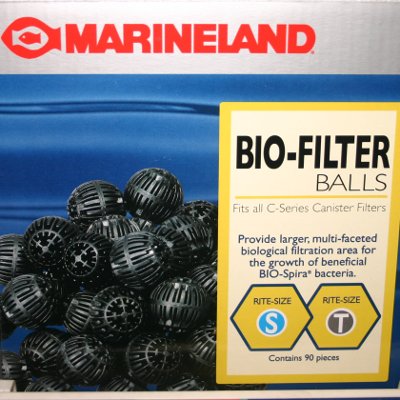
Marineland Bio-Filter Balls
Courtesy of Big Al's Aquarium Services
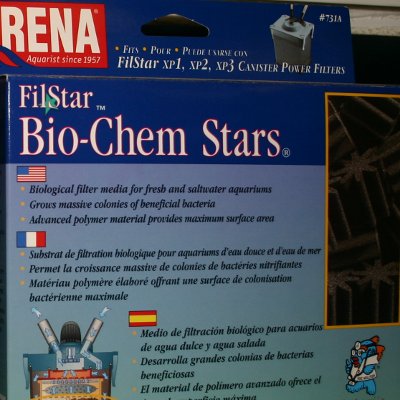
Rena Bio-Chem Stars
Courtesy of Big Al's Aquarium Services
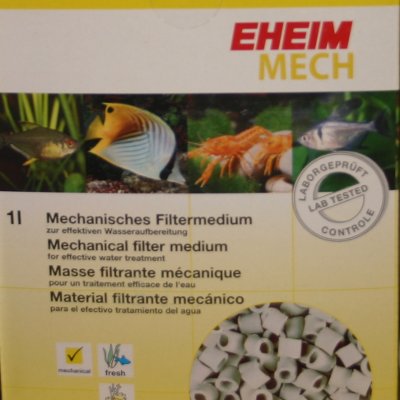
Eheim Ceramic Rings
Courtesy of Big Al's Aquarium Services
Selection of Biological Filter Media (Bio-Media)
There is currently a great deal of debate as to which bio-media is best to use in the modern bio-filter. I would first like to define some terminology, give some guidelines, and then let you be the judge of which bio-media is the best.
The significant parameters which can be used to determine the performance of the bio-media in question are: (1) Chemical Inertness, (2) Surface Area, (3) Void Space, (4) Wetability, (5) Tendency to Channel and (6) Tendency to Foul.
Any bio-media used in an aquarium bio-filter should be chemically inert in both fresh and saltwater. Chemical inertness depends upon the material the bio-media is composed of and, in general, bio-media that is manufactured for aquarium use is chemically inert.
Surface area per unit volume, usually given as square feet per gallon or square feet per cubic foot, is one of the most often quoted figures of bio-media. The magnitude of this figure will give some indication of the available surface area for beneficial gas exchange and for bacterial growth, but this figure is of little use unless other relevant information is also available. German literature often states that the quantity of bio-media for an aquarium should be approximately 1 gallon of bio-media for every 10 gallons of water. This figure is derived from the use of only one manufacturer's bio-media whose surface area per gallon is much different than that of other available bio-media. What we really need to know is how many square feet of bio-media surface area per gallon of water is necessary. In general, I have found that 1 square foot of bio-media surface area per gallon of fresh water, and 1.5 square feet of bio-media surface area per gallon of salt water is quite adequate. For example, if I have a 100 gallon fresh water aquarium, I will require a total of 100 square feet of bio-media surface area. If I find bio-media having 10 square feet of surface area per gallon, I will need 10 gallons of this bio-media and a bio-filter large enough to contain it.
Void space is another important parameter, which should also be considered when selecting bio-media. Essentially, "void space" is an expression of the air space remaining after a container has been filled with bio-media. An expression such as void space equals 90% means that a container filled with bio-media is still 90% air. In general, the less void space the bio-media has the greater the surface area, but this comes with a drawback, i.e. beneficial gas exchange. Take, for example, sand and gravel, which have low void space and high surface area. Because of the low void space, resulting in a low capacity for beneficial gas exchange, sand and gravel are not very good bio-media for bio-filters. A good void space figure is around 85% to 95%.
Wetability is a figure that is almost never provided by the manufacturer and can only be guessed from observation. The wetability of bio-media is simply its ability to get wet all over. In general, media having a ball or barrel shape wets more easily than media having a large flat surface because water flowing over round objects tends to wet them more evenly while water flowing over flat objects tends to wet only the top half, leaving the bottom half relatively dry. An example of a bio-media having good surface area, good void space, but poor wetability is plastic drinking straws. It can be observed that, even though drinking straws have a high surface area and good void space, unless the straw is oriented just so, water seldom gets a chance to flow through the inside of the straw, and if it does, it is almost certain not to touch the top half of the inside.
Another factor to consider when choosing bio-media is the tendency of the bio-media to disperse or channel the flow of water. A good bio-media should not disperse or channel too much or too little. Some bio-media have a tendency to disperse the flow of water outward and then down the sides of its container, resulting in a relatively dry cone shaped section of bio-media in the middle of the container. At the other extreme is bio-media which channels the flow of water straight down in streams, resulting in poor wetting of the surrounding media. Again, dispersion vs. channelization figures are almost never provided by the manufacture and can only be guessed at.
The last factor to consider in choosing a bio-media is its tendency to plug and foul, which should be avoided. Unlike a mechanical filter, which is best cleaned on a regular basis, once a bio-filter is established it should not be disturbed. Any bio-media that tends to plug and foul would have to be periodically removed and cleaned, or disposed of, resulting in a potential major biological upset in the aquarium. An example of a bio-media that has good surface area, good void space, good wetability and good dispersion, but which plugs and fouls easily, is filter foam.
Bio-Filter Design Criteria
Having discussed the performance objectives of bio-media, we are now in a good position to consider bio-filter design criteria, which will give us these objectives.
I am sure you now understand that the selection of good bio-media plays a major part in the overall performance of a bio-filter. A properly designed bio-filter will enhance that performance, while a poorly designed bio-filter will often diminish it. As far as bio-media performance is concerned, there are three guidelines which should be considered in the bio-filter design:
(1) Mechanical filtration of the aquarium water should take place prior to the water's entry into the bio-filter's chamber containing the bio-media.
(2) The bio-filter should disperse the incoming flow of water evenly over the top of its bio-media.
(3) The bio-filter should facilitate good ventilation of its bio-media so there is plenty of fresh air surrounding the bio-media at all times.
I would now like to discuss the above three guidelines in greater detail.

Aquarium Corner Overflow Box
Courtesy of Big Al's Aquarium Services
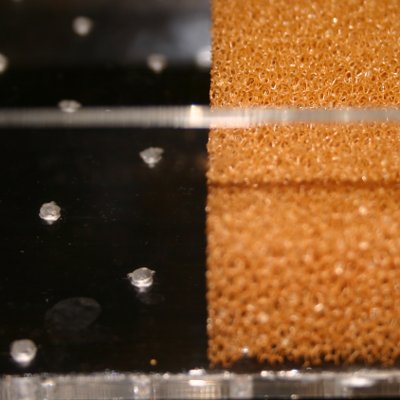
Drip Tray with Foam (Mechanical Filtration) Pad
Courtesy of Nautilus Aquatics, Inc.
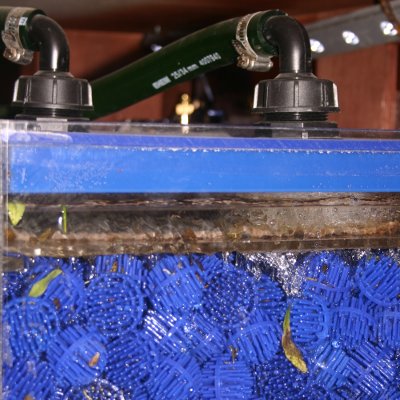
Working Bio-Filter
Courtesy of Big Al's Aquarium Services
Mechanical Filtration - In early bio-filter designs, a hole was drilled near one of the bottom back corners of the aquarium. A bulk head fitting was placed into the hole along with a perforated standpipe wrapped in filter floss or DLS (a double layer of spirally wound floss and separator material). The whole aquarium corner was then partitioned off such that water had to flow over the partition and through the floss material before leaving the aquarium via the standpipe and connecting hose below. This process is illustrated in many texts on "mini-reef" aquariums for anyone who might be unfamiliar with it. More recently, overflow boxes working on various leveling siphon principles have been developed, which eliminate the need to partition and drill the corner of the aquarium. Some of these overflow boxes also have provisions for some sort of mechanical filtration as well. An alternative to having the mechanical filter in a corner of the aquarium, or in an overflow box, is to incorporate the mechanical filter into the bio-filter itself just above the bio-media. This arrangement, if properly designed, affords a larger mechanical filter, facilitates easier maintenance and poses less potential for disaster should the mechanical filter suddenly become clogged.
Water Dispersion - There are many ways one could disperse water evenly over the surface of the bio-media, however, because of various bio-filter size constraints and costs involved, only two have gained much popularity. They are the spray bar and the drip tray. The design and action of a spray bar is very similar to that of the washer bars found in dishwashers. The spray bar consists of a perforated rotating arm connected to a Teflon washer or ball bearing joint. Water entering the spray bar causes the perforated arm to rotate over the top of the bio-media, thus dispersing the water flow. There are several things to look for when selecting a spray bar. First, the quality of the joint can vary from one spray bar to another. In the early days of bio-filter design there were many problems with joints seizing up over time. Secondly, unless the spray bar can be adjusted for flow rate, increasing the flow of water will also increase the speed at which the spray bar turns. A rapidly spinning spray bar causes water leaving the rotating arm to fly outward, missing the center section of the bio-media below. The alternative to the spray bar is the drip tray, which is nothing more than a shallow tray with an evenly perforated bottom. In its operation, water enters the drip tray and then flows across the bottom. As water fills the drip tray, it begins to drain down through the perforations and over the bio-media. The drip tray should be designed such that there is always a slight head of water inside the drip tray to ensure even drainage. Bio-filters using the drip tray method of water dispersion may also include a mechanical filter in the drip tray itself. Should the mechanical filter or some of the drainage holes in the drip tray becoming blocked by debris, water can continue to flow around the mechanical filter and through the remaining holes in the drip tray.
Ventilation - All things considered, proper ventilation of the bio-media is the most important function of the bio-filter, yet usually the least emphasized. Some manufacturers provide one or more nozzles at the sides of their bio-filters where air can be injected from an external air supply. This will work well provided that the nozzles are placed properly and connected to a good air source. An alternative to forced air ventilation is ventilation by convection, where a portal is provided at the top of the bio-filter and another at the bottom. In this arrangement, the bio-filter behaves like a chimney, causing ambient air to flow through the bio-media.
Conclusion
Besides providing a suitable container for bio-media, the modern bio-filter can also serve other useful functions as well. Some of these additional functions are: providing a place for chemical filtration, e.g. activated carbon and ion exchange resins, as well as a place for additional aquarium accessories, such as water heaters, thermometers, pH controllers, etc., all of which can be very unsightly in a beautiful display aquarium. Lastly, some bio-filters include float valves, or switches, which may be connected to an external water supply, facilitating the automatic replacement of water lost from evaporation or water removal.
I encourage those of you contemplating a bio-filter purchase, or the construction of your own bio-filter, to study the many bio-filter designs in light of the above information.








